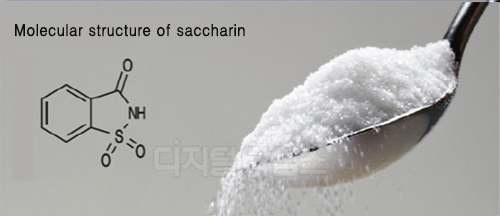Saccharine to clear its skirts from ‘Carcinogen’… Full action in medicine and food additives
Kim Ji Seob | cloud50@ | 2017-03-08 14:05:53

Sweetness is a taste that both men and women love. A few years ago, as a cooking researcher Baek Jong Won``s recipe, sweetness has become an issue up to this day. Sugar, starch syrup, honey, fructose, etc. are often used as sweeteners. And sugar is used in almost all processed foods among them. Not only variety of dishes but also beverages, coffee, tea types are also eaten or drunken with sugar. But there are also artificial sweeteners that sweeten food.
◇ The oldest artificial sweetener ``Saccharin`` = those who have suffered from obesity or diabetes have needed calorie-free substances instead of high-calorie sugar. It is the artificial sweetener that was created by the desire of these types of consumers. Especially saccharin, the oldest artificial sweetener, is sweet and has no calories, and its price is about 1/40 of sugar. Because saccharin is also stable in heat, it is easy to use for food and is favored by food processing companies.
Saccharin was discovered incidentally in February 1879 by Ira Ramson, a chemistry professor at Johns Hopkins University, and his student Constantine Fahlberg. Fahlberg was studying the chemicals oxidation in tar. Once he did not wash his hands after experimenting and ate bread, he felt sweet taste, and discovered saccharin to investigate the mechanism of this sweetness. After that, saccharin was sold in the United States in 1884 and in the UK markets in 1885. The ‘Korean Food Additives Codex`` explains that saccharin is a colorless or white powder that does not dissolve well in cold water but dissolves well in hot water, slightly soluble in ethanol and aqueous solution is neutral. The sweetness varies depending on the conditions of use, but it usually produces 200 to 700 times the sweetness of sugar. Also, the intensity of sweetness varies depending on the concentration. If the concentration is high, the sweetness is low. If the concentration is low, the sweetness is strong. Therefore, even if the concentration in the mouth is thin, there is a characteristic that the sweetness is long lasting.
Saccharin is widely used for people who are diabetic and who need to avoid sugar because they are released into the body as they are ingested. Saccharin is also used in making medicines and diet foods that the sugar cannot enter. Because of these advantages, Korea Fertilizer Co., Ltd. a subsidiary of Samsung Group, in 1966, tried to disguise saccharine as construction material and sell it. Recently, saccharin is attracting attention again due to the government``s declaration of`` War against sugar`` based on `` Comprehensive Sugar Reduction Plan ``of Ministry of Food and Drugs Safety in April last year.
◇ Controversy of saccharin harmfulness and worldwide scholars’ explanation= It is true that there is still a negative perception about saccharin. The study has begun in 1977 when a Canadian National Institutes of Health conducted a study on rats fed saccharin and found that they had cystitis. In 1981, the American Toxicology Research Program (NTP) and the International Agency for Research on Cancer (IARC) identified saccharin as the ``expected human carcinogen`` and in 1988, it was added to the list of cancer-causing chemicals in the United States.
However researchers say that animal experiments on saccharin by scientists were unrealistic at very high doses and that people do not develop bladder cancer due to saccharine. Joint FAO and WHO Joint Expert Committee on Food Additives (JECFA) conducted six rounds of carcinogenicity studies until 1993, concluding that saccharin is not a direct carcinogen for humans. The IARC lowered the grade of saccharin to ``not classifiable as a human carcinogen in 1998``, and in 2000 NTP removed saccharin from the carcinogen report. The US Food and Drug Administration (FDA) decided to remove the warning from saccharin-containing products in 2000. And in 2010, the US Environmental Protection Agency (EPA) removed the list of hazardous substances from the list of hazardous substances in the ‘Conservation and Recycling Act,’ which is a measure taken by the US National Calorie Control Association. It was based on a review of the evaluation. Saccharin is currently used worldwide including the United States, Japan and the European Union.
In Korea also, saccharin use has been continuously expanding as a kind of foods that are permitted to use saccharin since 2012 in response to the trend of deregulation of the world``s saccharin. Regarding food manufacturing, the Korea Food and Drug Administration has approved the use of saccharin for food products such as bread, sweets, candy, chocolate, ice cream and other foods in the November edition of the ‘Food Additives Standards and Specifications’. In September last year, the Life Science Convergence Science Team of Korea University Graduate School has revealed that saccharin inhibited cell proliferation in some cancer cells as a result of an anti-proliferative assay performed in vitro in four human cancer cells and one mouse cancer cell . In the experiment, the degree of anti-proliferative activity of saccharin against cancer cells was somewhat different according to the type of cell line, and further confirmation of the inhibitory effect was necessary. However it was confirmed that the darker the concentration of saccharin, the lower the cancer cells.
On the other hand, saccharin is used instead of sugar to maintain crisp texture in the case of kimchi, and when it is used in bread making, it is known to reduce calorie and to maintain its original sweetness with excellent heat stability. The use of saccharin is expected to increase even further in the future due to its benefits.
By Kim Ji Seob cloud50@
